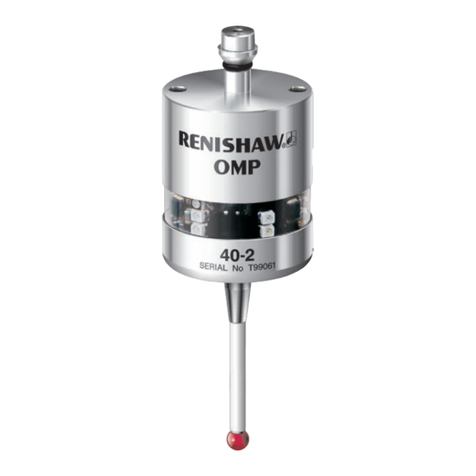
OLP40 installation guide
2.4
OLP40 basics
Enhanced trigger filter
Probes subjected to high levels of vibration or
shock loads may output probe trigger signals
without having contacted any surface. The
enhanced trigger filter improves the probe’s
resistance to these effects.
When the filter is enabled, a constant nominal
10ms delay is introduced to the probe output.
It may be necessary to reduce the probe
approach speed to allow for the increased stylus
overtravel during the extended time delay.
The enhanced trigger filter is factory set to OFF.
Optical transmission method
Probes subjected to particular forms of light
interference may accept spurious start signals.
The OLP40 can be operated in either ‘Modulated’
or ‘Legacy’ optical transmission mode.
Modulated mode
The OLP40 becomes compatible for use with
the OMM-2 or OMM-2C receiver with OSI or
OSI-D interface or with an OMI-2 / OMI-2T /
OMI-2H / OMI-2C receiver / interface to provide
substantially increased resistance to light
interference.
Modulated transmission in the OLP40, is capable
of providing three different coded start signals.
This allows the use of two probes with an OMI-2T
receiver / interface and up to three probes with
an OMM-2 receiver with a OSI or OSI-D interface
respectively.
Twin / multiple probe system
To operate in a twin or multiple probe system, one
probe must be set to PROBE 1 start and the other
probe must be set to PROBE2 start (OMI-2T or
OMM-2 with OSI or OSI-D) or PROBE3 start
(OMM-2 with OSI or OSI-D only). These settings
are user configurable.
In a twin probe system, such as a spindle probe
and an optical tool setting probe, the spindle
probe must be set to PROBE 1 start and the tool
setter to PROBE 2 start.
In a multiple probe system, with two spindle
probes and one optical tool setting probe, the
two spindle probes must be set to PROBE 1 and
PROBE 2 start, respectively, and the tool setter
must be set to PROBE 3 start.
Legacy mode
A start filter improves the probe’s resistance to
light interference.
When ‘Legacy’ (start filter on) is enabled, an
additional one second delay is introduced to the
probe activation (switch on) time.
It may be necessary to revise the probe program
software to allow for the increased activation time.
Optical power
Where the separation between the OLP40 and the
receiver is small, low optical power may be used.
In this setting, the optical transmission range
will be reduced, as shown on the performance
envelopes, so that battery life will be extended.
Low or ultra low optical power should be used
whenever possible for increased battery life.
Ultra low power is recommended for any
machine using the OMM-2C receiver or for use
in small machining centers where the maximum
separation distance between probe to receiver
is less than 1.5 m (4.9 ft), for further increased
battery life.
Dotted lines on the performance envelopes
represent the OLP40 in low and ultra low optical
power modes.
Maximum battery life is achieved when lithium-
thionyl chloride (LTC) batteries are used in
conjunction with ultra low power mode.
The probe is factory set to standard optical power.





























